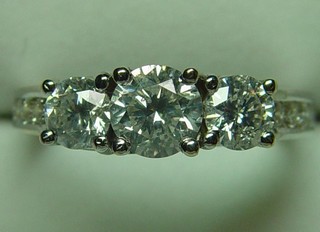Transparency in diamonds refers to the degree to which light can pass through the diamond’s material, offering a direct connection to the clarity and quality of the crystal. The transparency of a diamond is an important factor in its overall appearance, as it influences the brilliance and fire exhibited by the stone. A diamond with high transparency will allow light to pass through it more efficiently, resulting in a more vibrant, sparkling appearance, while a diamond with lower transparency may appear cloudy or hazy, diminishing its overall beauty and value.
Transparency is closely linked to the presence of inclusions and blemishes, which can block or scatter light as it passes through the diamond. The clearer the diamond, the more light it can transmit, enhancing its sparkle and overall visual appeal.
Factors Affecting Diamond Transparency:
Inclusions and Internal Clarity:
Inclusions are internal flaws within the diamond, such as air bubbles, mineral crystals, or other structural anomalies. These inclusions can block or scatter light, reducing the transparency of the diamond. A higher concentration of inclusions generally leads to poorer transparency.
Cloudy or milky diamonds are often the result of inclusions, which cause light to diffuse rather than pass through cleanly, creating a lack of brilliance.
Blemishes:
Blemishes, such as scratches or surface marks, can also affect transparency. Although blemishes are typically not as impactful as internal inclusions, they can still cause minor distortions in light transmission.
Surface blemishes may scatter light across the surface of the diamond, reducing its clarity and transparency.
Crystal Quality:
The overall quality of the diamond’s crystal structure plays a significant role in its transparency. Diamonds with well-formed, well-arranged, and pure crystal structures tend to have better transparency, as these diamonds are less likely to have inclusions that obstruct light.
Synthetic diamonds can sometimes have better transparency compared to natural diamonds because they are often grown under controlled conditions that reduce the presence of inclusions.
Grading of Transparency:
Transparency is typically evaluated by the presence of any factors that could diminish the passage of light through the diamond, such as inclusions, cloudiness, or haziness. In diamonds, clarity and transparency are often closely connected.
DCLA Transparency Grading System evaluates the degree of transparency based on how clearly light can pass through the diamond and how free the diamond is from inclusions or imperfections that would disrupt light transmission.
Transparency and Colour:
The transparency of a diamond can also be affected by its colour. While diamonds come in a range of colours, the more transparent and colourless a diamond is, the better the light can pass through it. The colourless diamonds (graded D in the GIA scale) typically offer superior transparency and brilliance.
Coloured diamonds, depending on their hue, may have a slightly reduced transparency, as the colour intensity can block some light from passing through the stone. However, high-quality fancy coloured diamonds can still exhibit excellent transparency and brilliance despite their colour.
Refraction and Light Performance:
The way a diamond refracts light, bending and reflecting it through its facets, plays a major role in its perceived transparency. A diamond with poor transparency may not refract light as well, leading to a loss of sparkle and brilliance.
Diamonds with superior transparency allow light to pass through the stone more easily, resulting in greater fire and brilliance, which are essential characteristics for a high-quality diamond.
Cut and Transparency:
The cut of the diamond significantly influences how well light travels through the diamond and how transparent it appears. A well-cut diamond will have optimal symmetry and proportions, ensuring that light enters and exits the stone in a way that maximises its brilliance and transparency.
A poorly cut diamond may trap light inside or cause light to leak out of the bottom, affecting the overall transparency and visual appeal of the stone.
Types of Transparency in Diamonds:
Clear or Transparent: Diamonds with little to no inclusions or blemishes that allow light to pass freely through the stone. These diamonds exhibit optimal brilliance and fire, and are highly valued for their transparency.
Cloudy or Milky: These diamonds have significant internal inclusions or other characteristics that block or diffuse light, reducing transparency. Cloudy diamonds may appear hazy or dull, with a reduced level of brilliance.
Opaque: In rare cases, diamonds can be so clouded by inclusions or internal defects that they are considered opaque, meaning they do not allow light to pass through at all. These diamonds have extremely low transparency and are generally considered unsuitable for use in jewellery.
Transparency Grading:
Transparency is not a standard grading factor on all diamond grading reports, but it can still be assessed by gemologists based on the visibility of inclusions and their impact on light transmission. The DCLA Transparency Grading System specifically assesses how a diamond’s transparency is affected by its internal and external characteristics, including inclusions, blemishes, and crystal structure. Diamonds with high transparency are generally considered more valuable and desirable, as they exhibit a greater ability to reflect and refract light, making them more brilliant and visually stunning.
Transparency is a key characteristic of a diamond’s overall appearance and value. A diamond with high transparency allows light to pass through it more effectively, enhancing its brilliance and fire. Factors such as inclusions, blemishes, and the quality of the crystal structure all play a significant role in determining a diamond’s transparency. Understanding transparency is crucial for evaluating a diamond’s overall clarity and how it performs in terms of visual appeal, sparkle, and brilliance. The DCLA Transparency Grading System helps to assess this aspect in more detail, providing an objective evaluation of the light transmission quality of diamonds.

